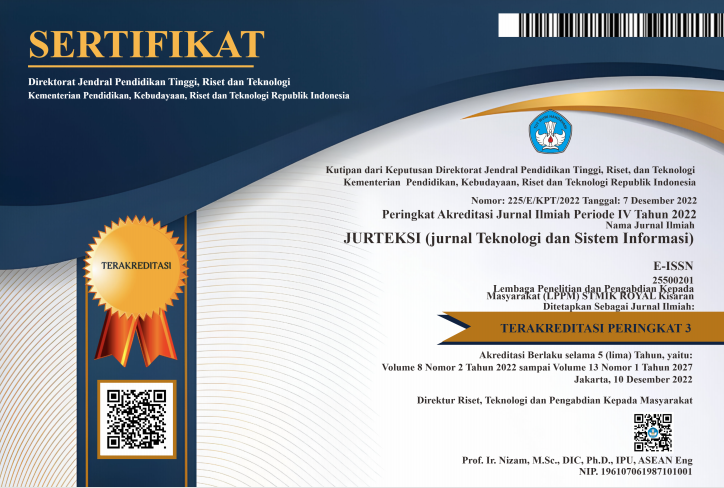CANNY EDGE DETECTION AND IMAGE SEGMENTATION FOR PRECISION FACE RECOGNITION SYSTEM
Abstract
Abstract: Facial recognition is widely used in areas such as video surveillance and database management. Facial images have been used as a preferred biometric feature in many identity recognition systems to obtain good image results in image segmentation. A good image must pay attention to several factors, namely high resolution, good contrast, image sharpness, consistent colors, lack of noise and appropriate lighting conditions. In this face recognition research, using canny edge detection method for 10 original images paired with 10 other images. The original faces taken are male and female. Canny edge detection has a low error rate in image segmentation compared to other edge detections. The purpose of this study is to determine the edge of the image in I-rat and can display the results of a good segmentation of facial images. The results of the test data with data stored in the database in the study is 1 face image produces 67.69% accuracy and 26.92% and 8 other face images produce 100% accuracy. The average success rate of 10 experiments using image segmentation is 89.461%. In conclusion, the canny edge detection method can provide accurate results in the face recognition process.
Keywords: accuracy; canny edge detection; face recognition; image; segmentation
Abstrak : Pengenalan wajah banyak digunakan dalam diberbagai bidang seperti pengawasan video dan manajemen basis data. Gambar wajah telah digunakan sebagai ciri biometrik yang disukai di banyak sistem pengenalan identitas untuk mendapatkan hasil citra yang bagus dalam segmentasi citra. Citra yang baik harus memperhatikan beberapa faktor yaitu resolusi tinggi, kontras yang baik, ketajaman citra, warna yang konsisten, kurangnya noise dan kondisi pencahayaan yang sesuai. Pada penelitian pengenalan wajah ini, menggunakan metode deteksi tepi canny untuk 10 citra asli yang dipasangkan dengan 10 citra lainnya. Wajah asli yang diambil berjenis kelamin laki-laki dan perempuan. Deteksi tepi canny memiliki tingkat kesalahan rendah dalam segmentasi citra dibandingkan dengan deteksi tepi lainnya. Tujuan dari penelitian ini adalah menentukan tepi gambar secara akurat dan dapat menampilkan hasil segmentasi citra wajah yang baik. Hasil dari data uji dengan data yang tersimpan di database dalam penelitian adalah 1 citra wajah menghasilkan akurasi 67,69% dan 26,92% dan 8 citra wajah lainnya menghasilkan akurasi 100%. Rata-rata tingkat keberhasilan dari 10 kali percobaan dengan menggunakan segmentasi citra adalah 89,461%. Kesimpulan, metode deteksi tepi canny dapat memberikan hasil yang akurat dalam proses pengenalan wajah.
Kata Kunci : akurasi; deteksi tepi canny; citra; pengenalan wajah; segmentasi
References
V. B. T. Shoba dan I. S. Sam, “A Hybrid Features Extraction on Face for Efficient Face Recognition,†Multimedia Tools and Applications, vol. 79, no. 31–32, hal. 22595–22616, 2020, doi: 10.1007/s11042-020-08997-1.
L. Li, Z. Xia, X. Jiang, F. Roli, dan X. Feng, “CompactNet: learning a compact space for face presentation attack detection,†Neurocomputing, vol. 409, hal. 191–207, 2020, doi: 10.1016/j.neucom.2020.05.017.
C. E. Widodo dan K. Adi, “Face geometry as a biometric-based identification system,†Journal of Physics: Conference Series, vol. 1524, no. 1, 2020, doi: 10.1088/1742-6596/1524/1/012008.
M. A. P. Chamikara, P. Bertok, I. Khalil, D. Liu, dan S. Camtepe, “Privacy Preserving Face Recognition Utilizing Differential Privacy,†Computers and Security, vol. 97, hal. 101951, 2020, doi: 10.1016/j.cose.2020.101951.
A. Hidayatno, R. R. Isnanto, dan K. Dhody, “Penentuan wilayah wajah manusia pada citra berwarna berdasarkan warna kulit dengan metode,†Teknologi Elektro, vol. 5, no. 2, hal. 1–8, 2006.
H. Liang, J. Gao, dan N. Qiang, “A novel framework based on wavelet transform and principal component for face recognition under varying illumination,†Applied Intelligence, no. ii, 2020, doi: 10.1007/s10489-020-01924-9.
A. Elngar dan H. Shaban, “Jou rna,†Expert Systems With Applications, hal. 114159, 2020, doi: 10.1016/j.eswa.2020.114159.
A. Bozorgmehr, M. Khaleqi Qaleh Jooq, M. H. Moaiyeri, K. Navi, dan N. Bagherzadeh, “A novel digital fuzzy system for image edge detection based on wrap-gate carbon nanotube transistors,†Computers and Electrical Engineering, vol. 87, no. August, hal. 106811, 2020, doi: 10.1016/j.compeleceng.2020.106811.
K. Wen, Z. Zhang, X. Jiang, J. He, dan J. Yang, “Results in Physics Image representation of structure color based on edge detection algorithm,†Results in Physics, vol. 19, hal. 103441, 2020, doi: 10.1016/j.rinp.2020.103441.
G. Karimi dan M. Heidarian, “Facial expression recognition with polynomial Legendre and partial connection MLP,†Neurocomputing, vol. 434, hal. 33–44, 2021, doi: 10.1016/j.neucom.2020.12.070.
S. T. H. Kieu, A. Bade, dan M. H. A. Hijazi, “Modified canny edge detection technique for identifying endpoints,†Journal of Physics: Conference Series, vol. 2314, no. 1, hal. 1–7, 2022, doi: 10.1088/1742-6596/2314/1/012023.
U. A. Nnolim, “Heliyon Automated crack segmentation via saturation channel thresholding , area classi fi cation and fusion of modi fi ed level set segmentation with Canny edge detection,†Heliyon, vol. 6, no. July, hal. e05748, 2020, doi: 10.1016/j.heliyon.2020.e05748.
J. Ulfah dan N. Nurdin, “Implementasi Metode Deteksi Tepi Canny Untuk Menghitung Jumlah Uang Koin Dalam Gambar Menggunakan Opencv,†Jurnal Informatika dan Teknik Elektro Terapan, vol. 11, no. 3, hal. 420–426, 2023, doi: 10.23960/jitet.v11i3.3147.
A. Munandar, M. H. Santoso, dan S. Sulistiyasni, “Jurnal Media Pratama Jurnal Media Pratama,†vol. 15, no. 1, hal. 43–61, 2021.
B. Rehman, W. Hong, O. Abby, C. Hong, T. Trung, dan D. Ngo, “Face detection and tracking using hybrid margin ‑ based ROI techniques,†The Visual Computer, no. 0123456789, 2019, doi: 10.1007/s00371-019-01649-y.
F. Spagnolo, S. Perri, dan P. Corsonello, “Design of a real-time face detection architecture for heterogeneous systems-on-chips,†Integration, vol. 74, no. October 2019, hal. 1–10, 2020, doi: 10.1016/j.vlsi.2020.04.008.
T. R. Fujimoto, T. Kawasaki, dan K. Kitamura, “Canny-Edge-Detection/Rankine-Hugoniot-conditions unified shock sensor for inviscid and viscous flows,†Journal of Computational Physics, vol. 396, hal. 264–279, 2019, doi: 10.1016/j.jcp.2019.06.071.
W. Iqbal, N. Khan, A. Mahmood, dan A. Erradi, “Canny edge detection and Hough transform for high resolution video streams using Hadoop and Spark Canny Edge Detection and Hough Transform for High Resolution Video Streams Using Hadoop and Spark,†no. March, 2020, doi: 10.1007/s10586-019-02929-x.
A. B. Prasetyo dkk., “Comparative Analysis of Image on Several Edge Detection Techniques,†TEM Journal, vol. 12, no. 1, hal. 111–117, 2023, doi: 10.18421/TEM121-15.
B. Kumar Shah, V. Kedia, R. Raut, S. Ansari, dan A. Shroff, “Evaluation and Comparative Study of Edge Detection Techniques Related papers Evaluation and Comparative Study of Edge Detection Techniques,†IOSR Journal of Computer Engineering (IOSR-JCE), vol. 22, no. 5, hal. 6–15, 2020, doi: 10.9790/0661-2205030615.













